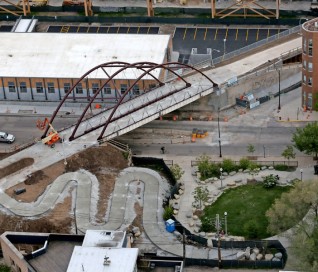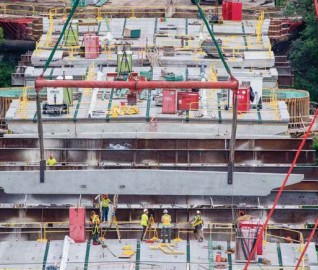
Originally a railway line developed in 1873, the Bloomingdale Line carried passenger and freight trains from the near north side of Chicago thirty-five miles out to the western suburbs. In 1910, a portion of the line in Chicago was elevated to help reduce pedestrian accidents at street crossings. By the late 1990s, rail traffic on the line had declined substantially, eventually halting in the early 2000s. The railway line sat largely abandoned until 2013 when the City of Chicago purchased a 2.7-mile segment of the railroad right-of-way and engaged Walsh Construction (Walsh) to develop this segment into The Bloomingdale Trail and Park, also known as “The 606.” This adaptive reuse project turned the railway into a landscaped elevated park for walkers, runners, and bikers, connecting multiple city neighborhoods and spurring economic development. The 606 repurposed more than thirty of the original steel bridges or concrete viaducts, including perhaps the most iconic component of The 606. The bridge over Milwaukee Avenue took a former four-span, simply supported bridge and converted it into a single-span, tied-arch bridge.
The engineer of record for the project was Collins Engineers Inc.; we served as the construction and erection engineer, assisting Walsh with an innovative erection plan for the bridge.
This article was originally published in the February 2018 issue of STRUCTURE magazine, exclusively published for the practicing structural engineer.
RELATED INFORMATION
-
 Scott Graham, Senior AssociateWJE Northbrook MORE >People | Scott Graham, Senior Associate
Scott Graham, Senior AssociateWJE Northbrook MORE >People | Scott Graham, Senior Associate -
 Jacking Procedure, Erection Procedure, and Tensioning Sequence MORE >Projects | The 606: Milwaukee Avenue Bridge
Jacking Procedure, Erection Procedure, and Tensioning Sequence MORE >Projects | The 606: Milwaukee Avenue Bridge -
 Investigation and rehabilitation design of this historic Minneapolis bridge (part 2 of 2) MORE >Articles | The Franklin Avenue Bridge—Part 2: Structural Analysis and Accelerated Bridge Construction
Investigation and rehabilitation design of this historic Minneapolis bridge (part 2 of 2) MORE >Articles | The Franklin Avenue Bridge—Part 2: Structural Analysis and Accelerated Bridge Construction -
 Degradation and changing usage led to the full replacement of the deck and spandrel cap beams. MORE >Articles | Franklin Avenue Bridge: Analysis, Design, and Accelerated Bridge Construction
Degradation and changing usage led to the full replacement of the deck and spandrel cap beams. MORE >Articles | Franklin Avenue Bridge: Analysis, Design, and Accelerated Bridge Construction



































